Menus
- Four wins or six sells?
- Honda CB 900 F Bol d‘Or timelessly beautiful and elegant
- Even passage without a hitch
- Front brake acts blunt
- Upright, relaxed, in a dignified sitting posture
- Hardly anything can be felt from gimbal reactions
- Z 1300 hits a mighty stake in the ground
- You could almost guess on chain
- Technical specifications
- Honda CBX
- Kawasaki Z 1000 ST
- Kawasaki Z 1300
- The motors
- Honda CB 900 F Bol d‘Or
- Honda CBX
- Kawasaki Z 1000 ST
- Kawasaki Z 1300
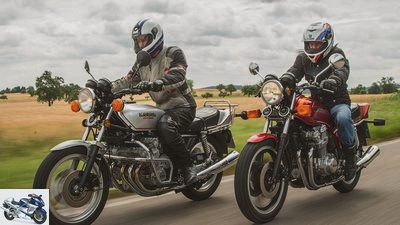
Arturo Rivas
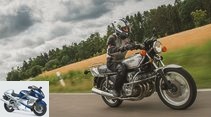
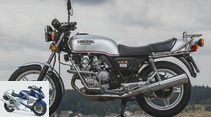
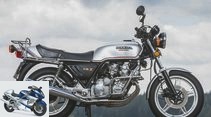
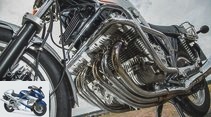
45 photos
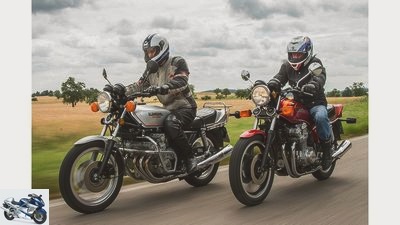
Arturo Rivas
1/45
Six against four for the first:
Honda CBX and Honda CB 900 Bol d’Or.
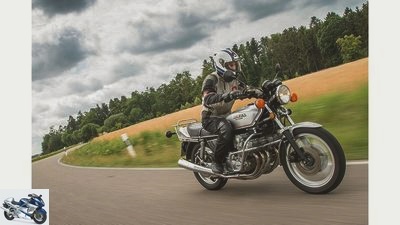
Arturo Rivas
2/45
Honda CBX.

Arturo Rivas
3/45
The closet-sized six-cylinder engine of the Honda is …

Arturo Rivas
4/45
… a real feast for the eyes and ears.
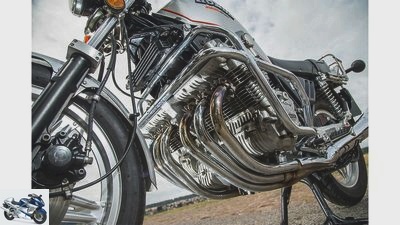
Arturo Rivas
5/45
The CBX engine belongs behind bars – for its own protection: a toppling over could have fatal and expensive consequences. The oil cooler provides the necessary cooling of the lubricant when driving wildly and / or on hot days.
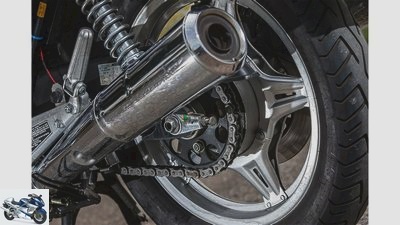
Arturo Rivas
6/45
The comparatively simple chain tensioner testifies to the cost pressure that also prevailed with the CBX, the silver Comstar wheels of the first series gave way to the black ones with upturned spokes only in 1980.
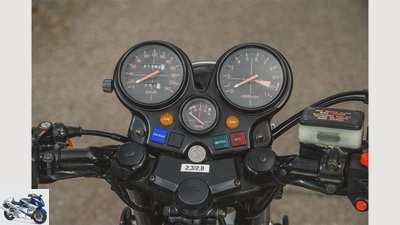
Arturo Rivas
7/45
The voltmeter in the cockpit proves to be an important indicator because of the susceptible alternator.
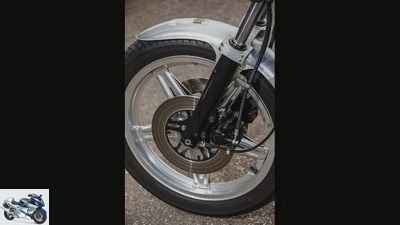
Arturo Rivas
8/45
Double disc brake on the front wheel.
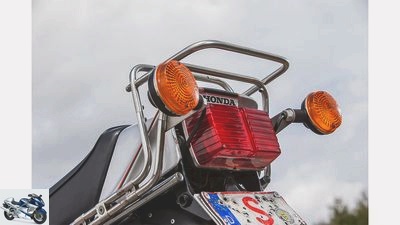
Arturo Rivas
9/45
Gorgeous turn signals put the rear light in the limelight.
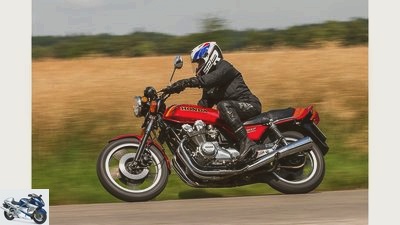
Arturo Rivas
10/45
Honda CB 900 F Bol d‘Or.

Arturo Rivas
11/45
"The classically beautiful design and the powerful four-cylinder inspire me every time anew, and given the low mileage of my Bol d‘Or, I will certainly enjoy it for a long time to come.", says Pit Spang, owner of the Honda CB 900 F Bol d‘Or.
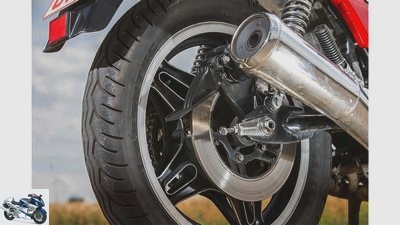
Arturo Rivas
12/45
"As a big Honda fan, I have long wanted to close the gap in my inline four-cylinder collection between the CB 750 Four and the CBX. The legendary 900 Bol d’Or was needed, I found it a few years ago at “my” Honda dealer." …
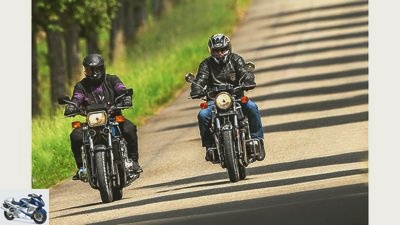
Arturo Rivas
13/45
Six against four for second:
Kawasaki Z 1300 and Kawasaki Z 1000 ST.
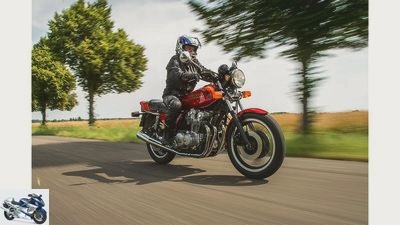
Arturo Rivas
14/45
Honda CBF 900 Bol d’Or.
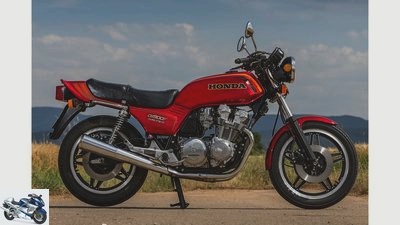
Arturo Rivas
15/45
The Bol d‘Or lives up to its name …
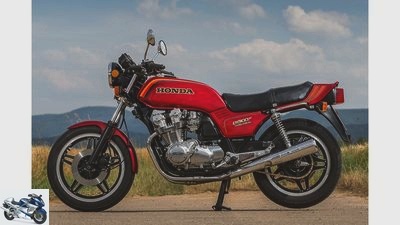
Arturo Rivas
16/45
… and proves itself worthy of its sporting history.
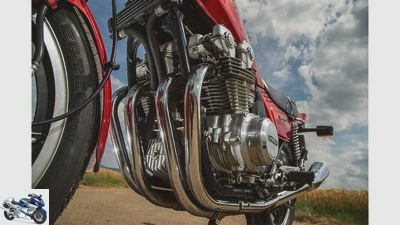
Arturo Rivas
17/45
The Bol d‘Or’s dohc engine is a beautiful and distinctive piece of engine manufacturing history.
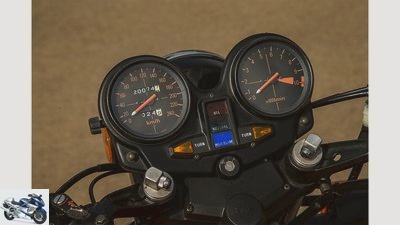
Arturo Rivas
18/45
Even in the classically styled, straightforward, but functional cockpit, the Honda proves that it is honest: at top speed the speedometer shows exactly 213 km / h
213 km / h.
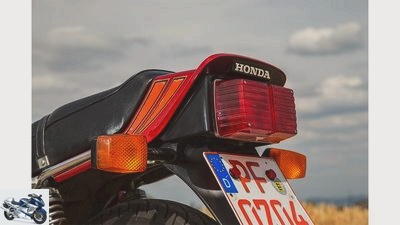
Arturo Rivas
19/45
The huge, ribbed rear light, which would also be a credit to an old S-Class, is emblazoned under the elegant rear bumper.
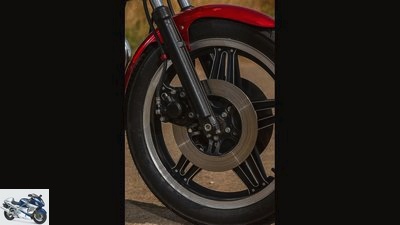
Arturo Rivas
20/45
Only the blunt, only moderately effective brakes built up to 1981 have to accept criticism.
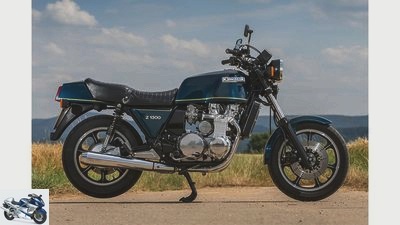
Arturo Rivas
21/45
The mighty six-cylinder block manages without cooling fins, instead it pushes a mighty water cooler through the wind, which ensures that the 1300’s temperature is balanced.
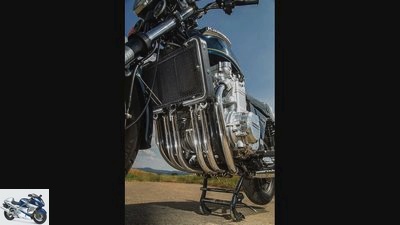
Arturo Rivas
22/45
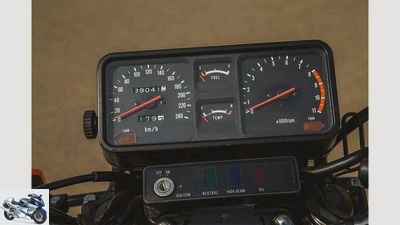
Arturo Rivas
23/45
Everything on the Z 1300 is big, bulky and angular – and consequently the cockpit too. Clear and easy to read, no frills, but with a useful fuel gauge and cooling water temperature display.
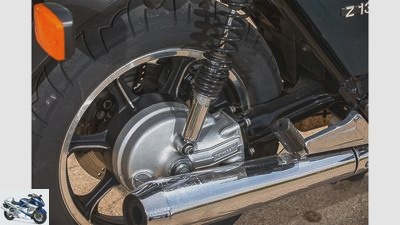
Arturo Rivas
24/45
On the other hand, things run pretty smoothly with the cardan, which does its work just as inconspicuously as with the 1000.
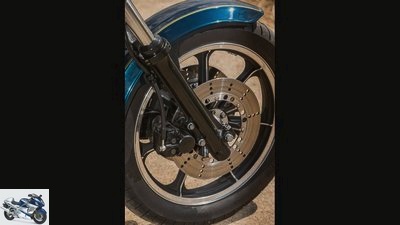
Arturo Rivas
25/45
Double disc brake on the Z 1300.

Arturo Rivas
26/45
Like the headlight, everything on the Z 1300 is a bit more angular instead of round – so are the indicators.

Arturo Rivas
27/45
"The sheer size, the design, the six-cylinder, its smoothness and the power delivery as well as the sound – that is, in a nutshell, what fascinates me about the 1300s. With all this, the thickness is always easy to drive. It is always a relief for me to switch from the two- and four-cylinder Rappelkisten and drive the silky 1300s. The motorcycle exudes such calm and sovereignty, which makes me slow down completely. It’s like driving a Rolls-Royce, only with a helmet."
Rolf Vogel, owner of the Kawasaki Z 1300.
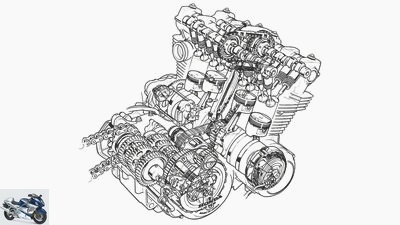
Honda
28/45
The four-cylinder of the Honda CB 900 F Bol d‘Or offers two overhead camshafts and four-valve technology – just like its racing ancestors.
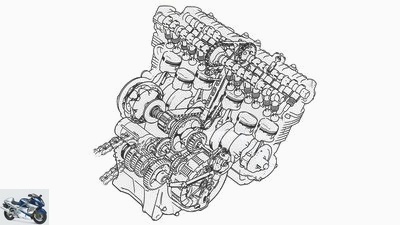
Honda
29/45
Until the appearance of the Honda six-cylinder, no production motorcycle could be adorned with the abbreviation 24V. The CBX engine shines with its smoothness and ease of revving.
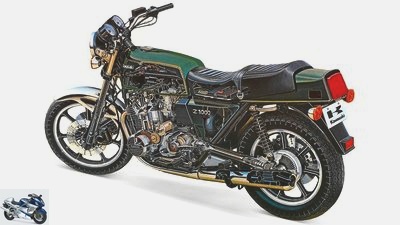
Kawasaki
30/45
The Z 1000 ST engine can look back on a long tradition. With the cardan drive, the ST deviates somewhat from the purely sporting claim.
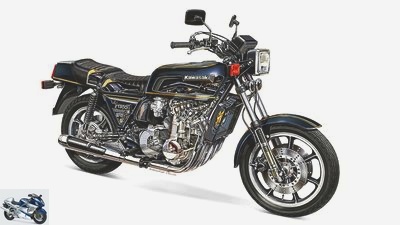
31/45
The solid, water-cooled six-cylinder of the Z 1300 seems to be built to last with “only” 100 hp and usually achieves high mileage in practice.
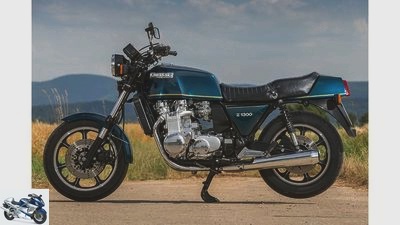
Arturo Rivas
32/45
"Driving the Z 1300 is a bit like driving a Rolls-Royce – only on two wheels and with a helmet."
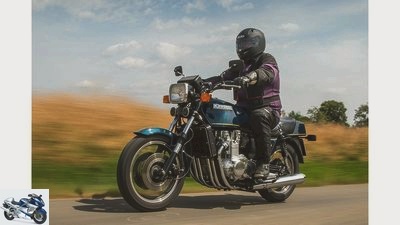
Arturo Rivas
33/45
Kawasaki Z 1300.
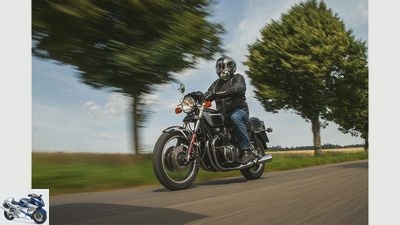
Arturo Rivas
34/45
Kawasaki Z 1000 ST.
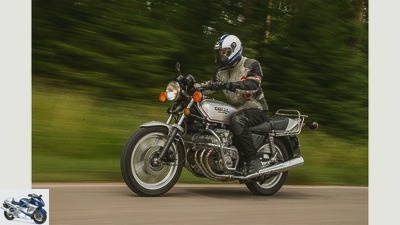
Arturo Rivas
35/45
Honda CBX.
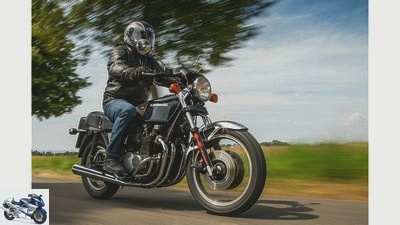
Arturo Rivas
36/45
Kawasaki Z 1000 ST.
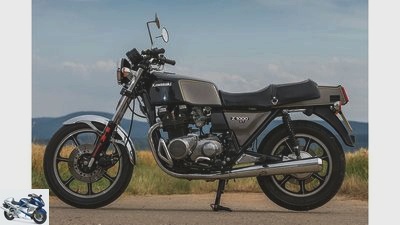
Arturo Rivas
37/45
The once maligned parallelogram design has long since achieved cult status.
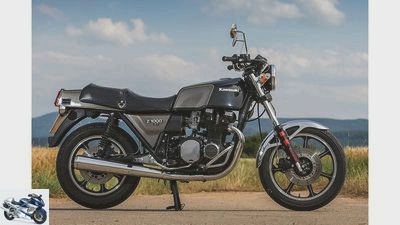
Arturo Rivas
38/45
Kawasaki Z 1000 ST.
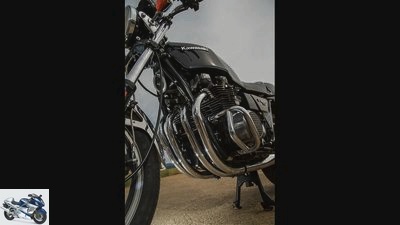
Arturo Rivas
39/45
Changes in the intake, exhaust and larger carburettors allow the well-known two-valve 1000 to produce 97 hp.
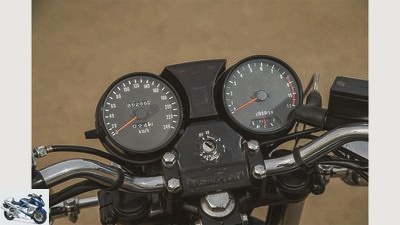
Arturo Rivas
40/45
In contrast to its chain-driven sister, the speedometer understates a little at top speed, the fuel gauge in the rev counter only has the ST.
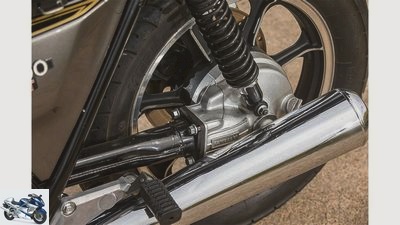
Arturo Rivas
41/45
The 1000er borrowed the inconspicuous, almost reaction-free cardan from the 1300er.
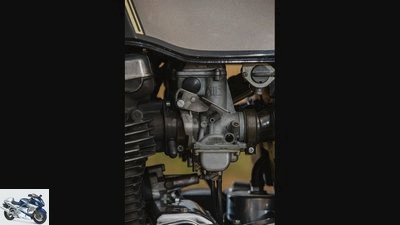
Arturo Rivas
42/45
For the morning cold start, the driver has to bend down to the side and operate the choke valve on the Mikuni carburetor
or readjust.
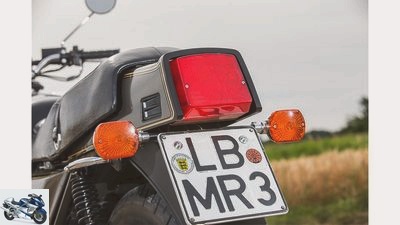
Arturo Rivas
43/45
"After the Z 650 B, in 1981 I was looking for a Kardantourer with four cylinders. I found my ST at a dealer at a retail price of 7600 marks. In the meantime, the Z 1000 ST was and is a loyal companion and now has over 85,000 kilometers on it." …
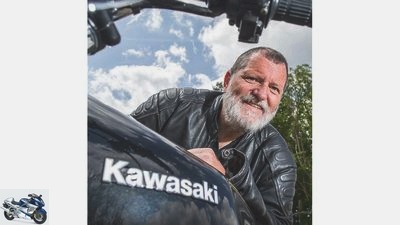
Arturo Rivas
44/45
"After about 60,000 kilometers, the cylinder base gasket had to be replaced. My second Z 1000 ST has already covered over 100,000 kilometers and is used for long tours year in, year out."
Peter Krauss, owner of the Kawasaki Z 1000 ST

Arturo Rivas
45/45
"This beautiful wall unit from a motor – you just want to stand in front of the CBX for hours and adore it. Which doesn’t mean that it wouldn’t drive great too. You quickly get used to the slight top-heaviness, and the sound of the air-cooled six-engine when accelerating through the entire rev range is simply beguiling. Sense or nonsense, weight or not – if I had to decide, I would always use the six-cylinder."
Gerhard Eirich, editor and driver of the Honda CBX.
On the move with the Honda CB 900 F Bol d‘Or, Honda CBX, Kawasaki Z 1000 ST and Kawasaki Z 1300
Four wins or six sells?
Content of
Is four two too little or six two too many? Does it depend on the number of cylinders, if so, who can book more advantages for themselves? Can the image advantage of the six-cylinder be offset by anything? Questions that Honda and Kawasaki raised in 1978 and that MOTORRAD Classic wants to help clarify today.
W.he says six-cylinder in-line, has smooth running in the head, wonderful hissing sound and at least upper middle class and corresponding image. Most of all, most of them think of four-wheeled vehicles. In any case, this was still the case at the end of the 1970s, when a large-volume four-cylinder was already regarded as the ultimate in motorcycles. Well, there was already a straight six from Italy, but the Benelli 750 Sei only found its way to Germany in manageable numbers. And 63 HP from 750 cm³ was not enough to shake the motorcycle world. It was precisely with this claim, however, that Honda entered the stage at the beginning of 1978 in order to stand up to the upgrading competition. With an outwardly impressive, air-cooled in-line six-cylinder, an enormous 595 millimeters wide, which broke the 100 hp barrier for the first time with 105 horses. A proud 24 valves controlled the gas exchange.
Buy complete article
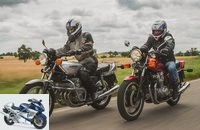
On the move with the Honda CB 900 F Bol d‘Or, Honda CBX, Kawasaki Z 1000 ST and Kawasaki Z 1300
Four wins or six sells?
Z 1000 MK II, whose card-driven sister, the Kawasaki Z 1000 ST, was supposed to hold up the four-cylinder tourer flag. But even Honda hadn’t slept and closed the gap between the 750 series and the six-cylinder flagship with the CB 900 F Bol d‘Or. It was also one of the eye-catchers at IFMA 1978. In 1979, bikers were spoiled for choice when it came to a big bike with around 100 hp.
Honda CB 900 F Bol d‘Or timelessly beautiful and elegant
At 8,853 marks, the Honda CB 900 F, mostly only known by its additional name Bol d’Or (“Golden Bowl”), was the quartet’s cheapest offer. Derived from the glorious 750 RCB long-distance racing machines that were in Follow won the legendary 24-hour race. The seriously aged CB 750 engine served as the basis for the production version, but everything above the engine housing has been thoroughly revised. Although the 900 series still has a long-stroke bore / stroke ratio, which is unusual for a sports engine, with two overhead camshafts and four valves per cylinder, the new four-cylinder was able to boast as advanced features as its big sister, the CBX.
With 95 PS, the Bol d’Or is very well motorized, and the new outfit in the so-called Euro design is still considered timelessly beautiful and elegant to this day. Our photo copy belongs to Honda fan and collector Pit Spang, who bought his Bol d’Or a few years ago from a trusted Honda dealer. A model from 1980, so already with the first modifications that Honda had added to the 900: the swing arm is already guided in needle bearings instead of the plastic bushings, the telescopic fork shines with air support and the spokes of the Comstar wheels are reversed. It is not known who exchanged the tank for a specimen (with a different decor) from the 750 Bol d’Or from the 1981 vintage. “I bought it like that,” reveals Pit. The technical condition leaves nothing to be desired, the engine running makes the mileage appear credible.
Even passage without a hitch
The first photos with Pit on the handlebars are in the can, he hands the Honda over to me to collect driving impressions until the next photo location. The engine is more than warm, so I can safely ignore the choke lever that can be operated with the thumb. The engine picks up the throttle cleanly and willingly, the clutch can be activated easily and precisely and the gears changed. The sitting posture is sporty and relaxed, that is to say, the upper body is supported casually and only slightly inclined on the wide, comfortably cranked handlebars, while the legs rest quite strongly angled on the high-mounted pegs. The 900 accelerates pleasantly smoothly, pulls up cleanly from 2000 rpm and starts working unexpectedly hard from 3000 tours. No trace of the sharp characteristics of a sports motorcycle. But after the even draft without a trailer, the fire comes too – if you stop the gas and let the air flow through the intake port of the 32-series Keihin constant pressure carburetor, you can also harvest a storm. From 7000 rpm, the Bol d’Or lives up to its name and racing history and, if necessary, hits the red zone from 9500 rpm. The whole thing is accompanied by a wonderfully pithy, pressed, hissing four-cylinder sound.
I take it more gently and prefer to register when and how strong the vibrations are noticeable. They are clearly noticeable from 5000 rpm, and the CB cannot deny a slight tingling sensation in the handlebars and in the seat. The appealing fork and the 30-way adjustable struts, borrowed from the CBX (the spring is five-fold, the compression three-fold and the rebound two-fold adjustable), ensure good driving stability and keep the 900s on track to let. The Honda leans surprisingly lightly, but rapid changes of direction suffer from the high gyroscopic forces of the 19-inch front wheel.
All tests and articles about the Honda CB 900 F Bol d‘Or
Front brake acts blunt
Nevertheless – if you shoot yourself a little bit at the CB, you can still let it run quickly today. But he should drive far ahead, because the front brake with the two-piston floating calipers has a blunt effect in terms of metering and quite poor in effect – good that the much more effective rear brake can help here. The more snappy double-piston calipers were only available for the CB from the 1981 vintage, together with the more stable fork with 37 instead of 35 standard tubes.
Incidentally, the Honda flagship Honda CBX also had to be content with thin 35-millimeter fork tubes – the built-in fork was already used in the old CB 750 F2. Can that be enough to give a 274 kilogram trump with the full tank the necessary stability? The first tests at the time spoke of unrest in fast corners and moderate straight-line stability from 160 km / h. Well we’ll see.
Upright, relaxed, in a dignified sitting posture
The first contact is less awe-inspiring than expected: The mighty engine makes the Honda CBX look quite top-heavy from the first few meters, but otherwise it is very easy to move. When the engine is cold, the 1000 requires a long time for choke help until it lapses into stable idle with a slight rumble from the clutch basket. Not tragic, says Pit, who also bought his low-mileage CBX a few years ago from his Honda dealer. The first thrusts give an idea of the sound that may arise at high speeds and already reveal the fabulous running culture of a six-transmitter. As is typical for Honda, the clutch and transmission are uncomplicated here – smooth-running, precise, the Japanese were able to do that 35 years ago. The adjustable handlebar stubs are turned a little too far forward for my taste, cranked too weakly, but otherwise you are enthroned on the Honda CBX extremely appropriately: upright, relaxed, in a dignified posture that should also be good for long distances. Old test values for fuel consumption were between nine and 14 liters and should significantly limit the range. This is not an issue today, small and medium-sized country roads are popular, where handling and suspension comfort have to prove themselves. What was already the case for the 900s can also be attested here: The fork is pleasantly sensitive, the struts are firm and do not tend to pump – that’s how we like it.
Well, let’s see what happens at a higher pace. The oil has long been at operating temperature, the end of town is approaching, I itches to give the six-cylinder in second and third gear the spurs and listen to the sound before the airstream drowns everything. Without grumbling, the 24-valve engine accepts the gas command at 2000 rpm, pulls up cleanly and without a hole, turns up the speed range seemingly effortlessly and absolutely vibration-free, without noticeable kick, just evenly and turbine-like. Switch? With 7000 tours it is completely sufficient, only those who are really in a hurry can stop at 9500 rpm until the beginning of the red area. The sound changes from the subdued cultivated grumbling like a dignified limousine to throaty roaring to the hoarse roar of an old Ferrari racing car – simply great. If the hair on the back of the neck does not stand up here, there is not a drop of gasoline in their blood. With the grin still on my face, I forgive the Honda for the fact that it cannot deny its front-heaviness and the 19-inch front wheel in the soon-to-be-approaching bend and that it wants to push out of the bend over the latter, is not a handling miracle and its blunt acting front brake is more of a Eight-finger brake is more than a two-finger brake – you sometimes want to grab hold of both hands … If you have a smooth driving style without racing late braking, the CBX can, however, speed over curved country roads, not least thanks to the Bridgestone BT 45 all-purpose weapon installed today. Incidentally, night driving with the CBX is also no problem – in 1979 it was by no means a matter of course, as was the CB 900 F with bright H4 lights.
Rearview mirror PDF: Test Honda CBX (MOTORRAD 11/1978)
Hardly anything can be felt from gimbal reactions
This is missing from the Kawasaki Z 1000 ST – a small flaw that was already criticized at the time when it was introduced. After all, they followed in big footsteps and led a big name, the Z 1000 MK II and the Z 1000 ST. Together with the Z 1300, they were presented at the IFMA in Cologne in 1978, tellingly under the slogan “Join the Force”. So it was about power, about power, possibly defending the supremacy in the big bikes against the CB 900 F and CBX. In terms of price, the cardan version Z 1000 ST (for shaft transmission), which is more suitable for tours, was a good thousand higher than the Honda competitor at 9968 marks and also outperformed it in terms of performance. Its 97 hp four-cylinder is based on the good old engine of the basic Z 1000, but thanks to some modifications it delivers over ten hp more. The contactless transistor ignition is also new, and the frame for the ST has been completely redeveloped due to the cardan drive.
This and other features, but above all the price, made the owner of our photo bike sit up and take notice in 1981. Peter Krauss, also known to many as the chairman of the Z-Club-Germany, discovered the ST at a dealer near Cologne at the “low-cost price of 7600 marks”. The ST did not skimp on technical refinements. In the steering head and the swing arm, tapered roller bearings ensure precise guidance, where the MK II has to be content with ball or needle bearings. The fork with a generous 200 millimeters of spring travel even comes from the Z 1300.
When starting with a cold engine, the two-valve engine proves to be a good companion, but requires a little longer for choke support. To do this, unlike the Hondas, a flap must be operated directly on the carburetor. The four willingly hangs on the gas, can be gently accelerated from 1500 tours and immediately gives the driver a feeling of home. The Kawasaki Z 1000 ST comfortably embeds the pilot on the well-padded bench and lets him enjoy a comfortable leg posture and the perfectly fitting, pleasantly cranked handlebar shape. Start-up, first, second gear, no noticeable elevator effect, hardly any cardan reactions can be felt. The vibrations of the roller-bearing four-cylinder engine are more likely to speak up as the engine speed increases: If the Kawa engine is even smoother than the Honda quad, it tingles clearly from the middle engine speed range and the mirrors start to tremble. The whole thing is accentuated by the Kawa-typical muffled hum with slightly howling / whistling undertone, which increases to angry roar in the last third of the speed range. There, the 1000 series also tugs on the chain, pardon me, on the cardan shaft, while it takes a short breath in the middle and doesn’t pull through the speed range quite as evenly as the Bol d’Or. What makes the Z 1000 ST hardly any slower overall, the Honda is only ahead of the curve when it comes to pulling through. The Kawa has other strengths: It is more comfortable, has more comfortable suspension without being spongy and it brakes better. Not outstanding, with their two-piston fixed caliper brakes, but more controllable and crisp, with a strong pull on the lever. The Z 1000 model, sometimes mocked as a cardan bucket, can be chased through the ground more quickly than some expected. And the parallelogram design, which was initially reviled and which was too angular for some fans of the rounded shapes that had prevailed until then, has long since enjoyed great popularity.
Z 1300 hits a mighty stake in the ground
The Kawasaki Z 1300 follows this design language with the angular design to perfection. Tank, rear bumper, rectangular headlights, the indicators the size of a playing card, even the instrument console – everything angular and angular, nothing more of the round shapes of bygone Kawa days. The 1300s knocks a mighty stake into the earth in every way. Six cylinders, water-cooled, 120 hp, over 320 kilograms in weight – data and facts that made eyes wide at the presentation and that should make one thing very clear: This is a men’s motorcycle, not for weak boys. She shows that to anyone who tries to lift the colossus onto the main stand. What is easy, and the easiest of all, to do with the six-cylinder Honda, thanks to the favorable leverage, turns into a feat of strength with the 1300. Pushing and maneuvering is not fun, also because of the small steering angle. However, it begins all the more impressive with sitting up and taking up the majestic, relaxed sitting position on the softly upholstered chairs. The hands automatically take the position on the optimally shaped, half-height handlebars, the notch arrangement allows an equally perfect leg posture.
You are in the right mood when you start the straight six. With a subtle hissing, which is very well muffled by the water jacket, the mighty engine reports to work, and with short thrusts of throttle it shows its willingness to perform with a pressed grumble. During our conversation during the photo breaks, the term Rolls-Royce on two wheels falls. That’s pretty good. Large, comfortable, luxurious (including “immobilizer” and automatic turn signal reset), dignified. And performance? Sufficient. Unlike the British car manufacturer, Kawasaki does give precise data, even if only 100 PS remain of the initially sensational 120 PS as part of the voluntary self-restraint agreed at the time by the manufacturers for Germany. The throttling takes place through orifices in the intake tract and smaller main nozzles. Nevertheless, over 100 Nm of torque at 6000 rpm is a word and capable of vehemently catapulting even 322 kilos plus driver forward.
This quickly becomes clear after the start. The engine oil is still warm, I can accelerate a little, even if I stay away from the red zone at 8000 rpm (which is also where the maximum power is applied). With a gentle and jerk-free thrust, the 1300 reacts to the twist of the throttle, pulls like a bull from an increased idle speed and pushes evenly through the speed range, increasing in power, that it’s a real delight. Accompanied by the pressed rumble from 3500/4000 tours, accompanied by the turbine-like whistling and howling of the numerous auxiliary units.
You could almost guess on chain
Standing up or hardening of the hindquarters? Nothing. You could almost guess the chain, the cardan of the Kawasaki Z 1300 behaves as inconspicuously as the exact shifting and the smooth clutch. Despite the generous suspension travel, the fat Kawa never looks spongy, it pulls its course neatly in curves and, at least during our test drive, never stirs or wobbles. The effort in terms of the chassis should pay off, the three mighty pipes that form the backbone of the double loop frame are generously dimensioned. It feels at least as handy as the CBX, but above all the driving behavior is more balanced and harmonious. The Z 1300 does not want to tip over the 18-inch front wheel into tight corners, as the CBX tries with the 19-inch front wheel. It is also gratifying that Kawa has given his thick ship appropriate brakes: Despite the comparatively small 260 mm discs and unspectacular two-piston floating calipers, the system shines with great controllability and crisp deceleration. Two to three fingers are sufficient here.
So braking is fun, and the subsequent acceleration allows you to get intoxicated by the wonderful rumbling sound from medium revs. Most Z 1300 owners hardly care that a lot of fuel rushes through the three Mikuni twin carburettors (less than eight liters / 100 km is only possible with real restraint, more than ten is easy; the injection version from 1984 consumes a little less). The mighty, long-stroke six-cylinder needs to be supplied – with gasoline and oil, whose “correct fill level should be checked often and meticulously”. Owner Rolf Vogel knows what he’s talking about: his lavish Kawa collection includes, in addition to various 1000s, eight other Z 1300s.
MOTORCYCLE market: Used Kawasaki Z 1300
Technical specifications




45 photos
Images: On the road with a Honda CB 900 F Bol d‘Or, Honda CBX, Kawasaki Z 1000 ST and Kawasaki Z 1300
To home page

Arturo Rivas
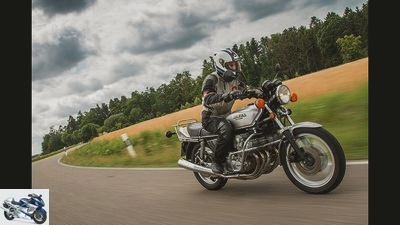
Arturo Rivas
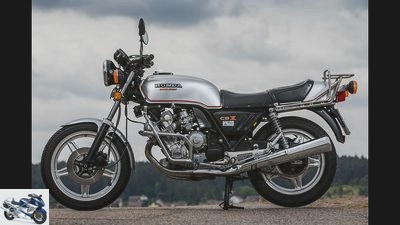
Arturo Rivas
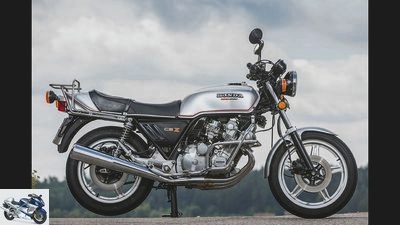
Arturo Rivas

Arturo Rivas
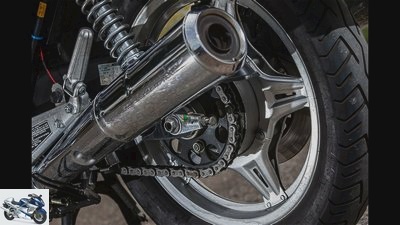
Arturo Rivas
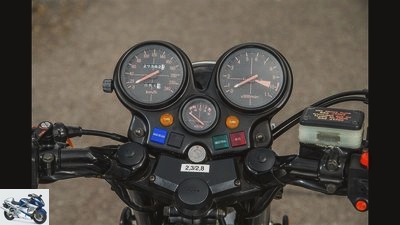
Arturo Rivas
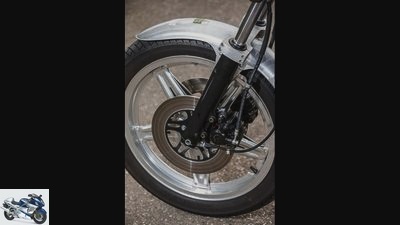
Arturo Rivas
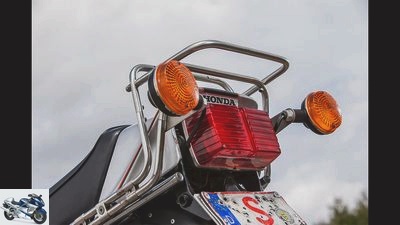
Arturo Rivas
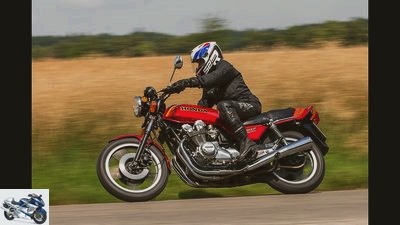
Arturo Rivas
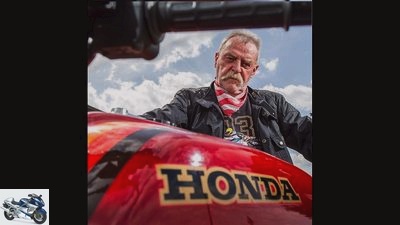
Arturo Rivas
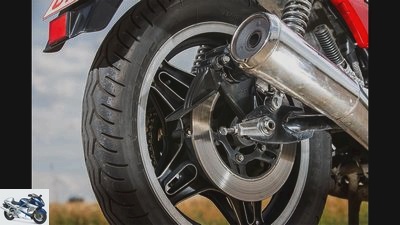
Arturo Rivas
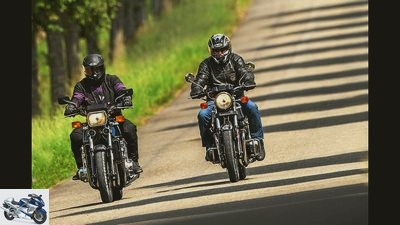
Arturo Rivas
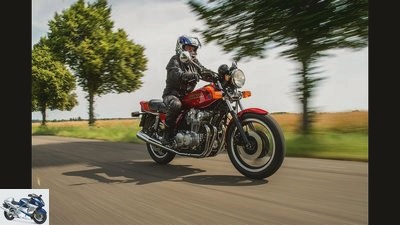
Arturo Rivas
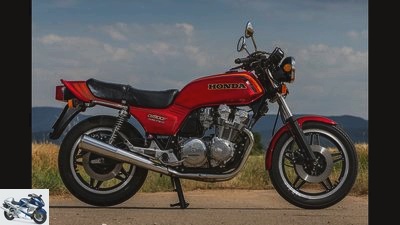
Arturo Rivas
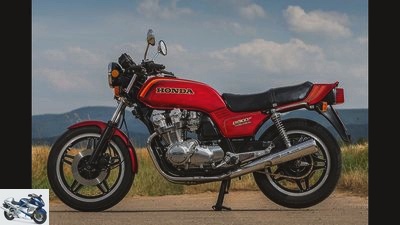
Arturo Rivas
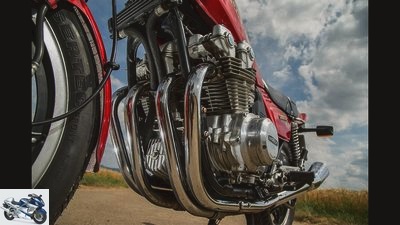
Arturo Rivas
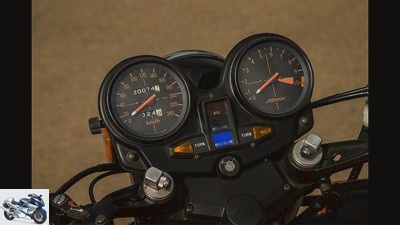
Arturo Rivas
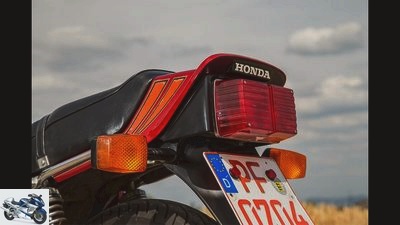
Arturo Rivas
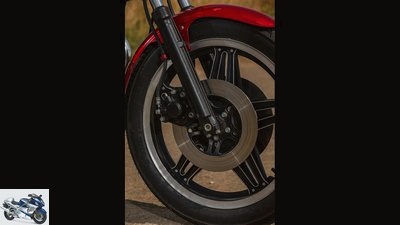
Arturo Rivas
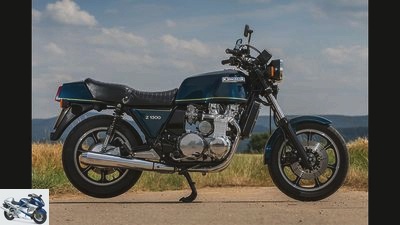
Arturo Rivas
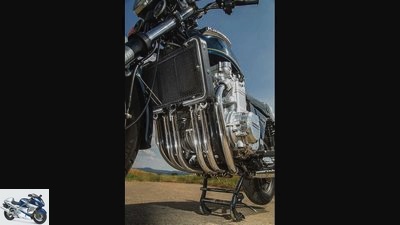
Arturo Rivas
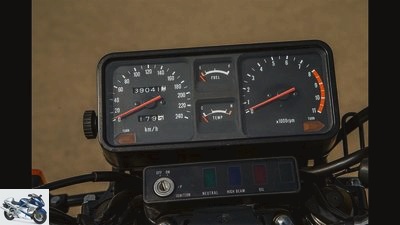
Arturo Rivas
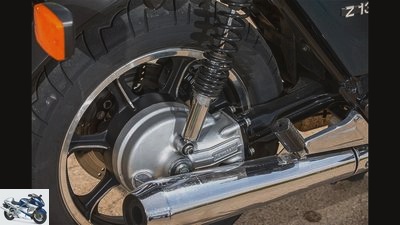
Arturo Rivas
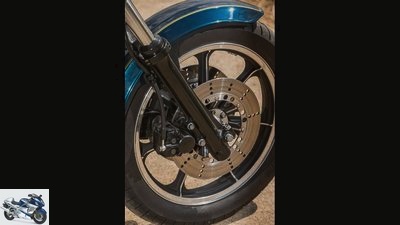
Arturo Rivas

Arturo Rivas
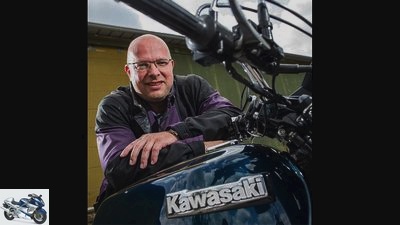
Arturo Rivas
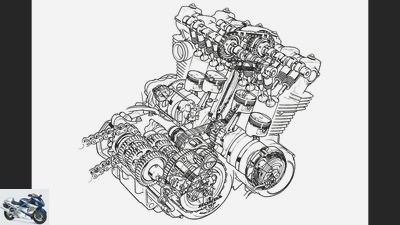
Honda
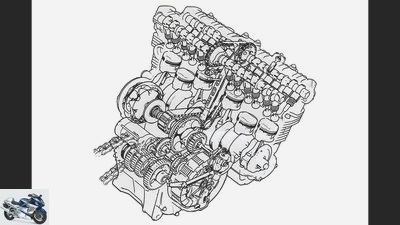
Honda
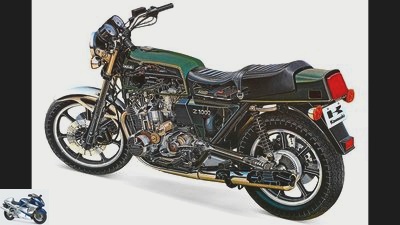
Kawasaki
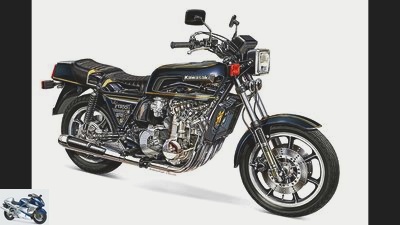
archive
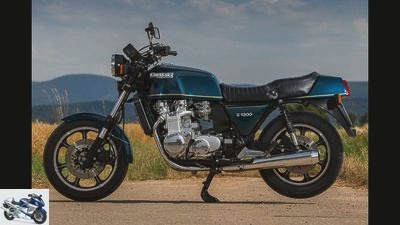
Arturo Rivas
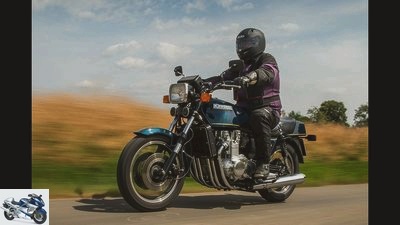
Arturo Rivas
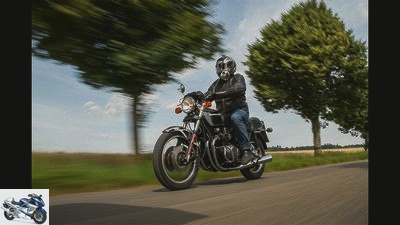
Arturo Rivas
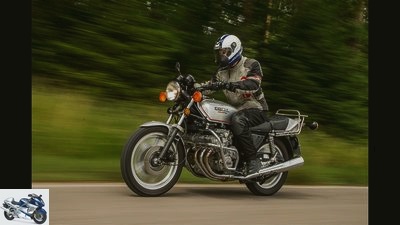
Arturo Rivas
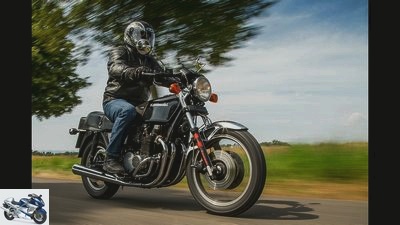
Arturo Rivas
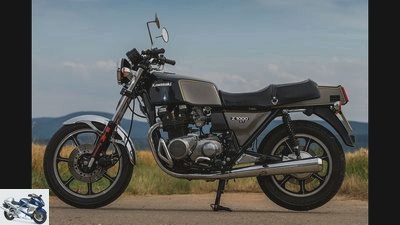
Arturo Rivas
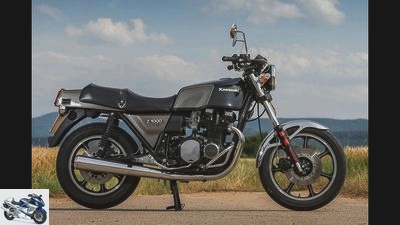
Arturo Rivas

Arturo Rivas
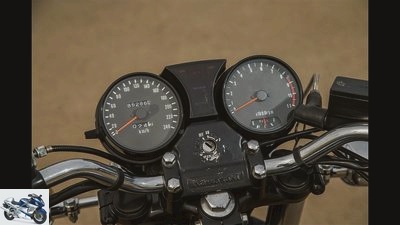
Arturo Rivas
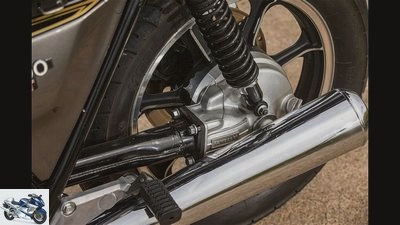
Arturo Rivas
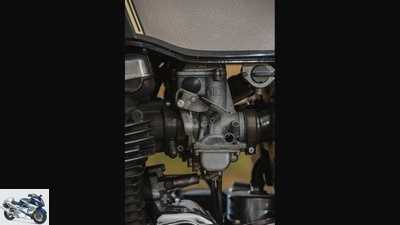
Arturo Rivas
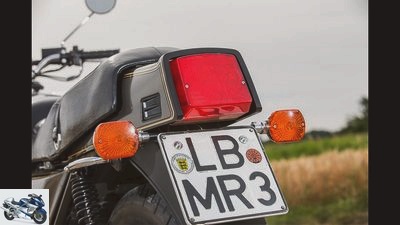
Arturo Rivas
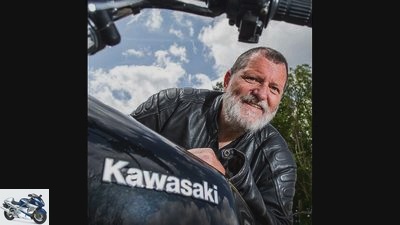
Arturo Rivas

Arturo Rivas
Honda CB 900 F.
Arturo Rivas
The Bol d‘Or lives up to its name and is worthy of its sporting history.
Engine:
Air-cooled inline four-cylinder four-stroke engine, two overhead camshafts, four valves per cylinder operated by bucket tappets, bore x stroke 64.5 x 69 mm, compression 8.8: 1, displacement 902 cm³, power 95 hp at 9000 / min, torque 77 Nm at 8000 rpm
Power transmission:
Multi-disc oil bath clutch, five-speed gearbox, chain drive
Landing gear:
Double loop tubular steel frame, hydraulically damped telescopic fork at the front, Ø 35 mm, Comstar aluminum rims, tires front 3.25 V 19, rear 4.00 V 18, double disc brake front, Ø 276 mm, disc brake rear, Ø 296 mm
Mass and weight:
Wheelbase 1515 mm, weight with a full tank
260 kg, tank capacity 20 l
Mileage:
Top speed 213 km / h
Factory price (1979):
8853 marks
Honda CBX
Arturo Rivas
The wall-mounted six-cylinder engine is a real feast for the eyes and ears.
Engine:
Air-cooled in-line six-cylinder four-stroke engine, two overhead camshafts, four valves per cylinder operated by bucket tappets, bore x stroke 64.5 x 53.4 mm, compression 9.3: 1, displacement 1046 cm³, output 105 hp at 9000 / min, torque 84 Nm at 8000 rpm
Power transmission:
Multi-disc oil bath clutch, five-speed gearbox, chain drive
Landing gear:
Double tubular frame, open at the bottom, hydraulically damped telescopic fork at the front, Ø 35 mm, Comstar aluminum rims, tires front 3.50 V 19, rear 4.25 V 18, double disc brake front, Ø 280 mm, disc brake rear, Ø 300 mm
Mass and weight:
Wheelbase 1495 mm, weight with a full tank
274 kg, tank capacity 23.8 l
Mileage:
Top speed 220 km / h
Factory price (1979):
10,963 marks
Kawasaki Z 1000 ST
Arturo Rivas
The once maligned parallelogram design has long since achieved cult status.
Engine:
Air-cooled in-line four-cylinder four-stroke engine, two overhead camshafts, two valves per cylinder operated by bucket tappets, bore x stroke 70 x 66 mm, compression 8.7: 1, displacement 1016 cm³, power 97 hp at 8000 / min, torque 90 Nm at 7000 / min
Power transmission:
Multi-disc oil bath clutch, five-speed gearbox, cardan drive
Landing gear:
Double loop tubular steel frame, hydraulically damped telescopic fork at the front, Ø 40 mm, cast wheels, tires front 3.50 V 19, rear 4.50 V 17, double disc brake front, Ø 280 mm, disc brake rear, Ø 280 mm
Mass and weight:
Wheelbase 1535 mm, weight with a full tank
276 kg, tank capacity 18.3 l
Mileage:
Top speed 214 km / h
Factory price (1979):
9968 marks
Kawasaki Z 1300
Arturo Rivas
“Driving the Z 1300 is a bit like driving a Rolls-Royce – only on two wheels and with a helmet”.
Engine:
Liquid-cooled in-line six-cylinder four-stroke engine, two overhead camshafts, two valves per cylinder operated by bucket tappets, bore x stroke 62 x 71 mm, compression 9.9: 1, displacement 1286 cm³, power 100 hp at 8000 rpm, torque 102 Nm at 6000 / min
Power transmission:
Multi-disc oil bath clutch, five-speed gearbox, cardan drive
Landing gear:
Double-loop tubular steel frame, hydraulically damped telescopic fork at the front, Ø 41 mm, cast wheels, tires front 4.10 V 18, rear 5.10 V 17, double disc brake front, Ø 260 mm, disc brake rear, Ø 250 mm
Mass and weight:
Wheelbase 1580 mm, weight with a full tank
322 kg, tank capacity 26.8 l
Mileage:
Top speed 217 km / h
Factory price (1979):
12,068 marks
The motors




45 photos
Pictures: On the road with Honda CB 900 F Bol d‘Or, Honda CBX, Kawasaki Z 1000 ST and Kawasaki Z 1300
To home page

Arturo Rivas

Arturo Rivas

Arturo Rivas

Arturo Rivas

Arturo Rivas

Arturo Rivas

Arturo Rivas

Arturo Rivas

Arturo Rivas

Arturo Rivas

Arturo Rivas

Arturo Rivas

Arturo Rivas

Arturo Rivas

Arturo Rivas

Arturo Rivas

Arturo Rivas

Arturo Rivas

Arturo Rivas

Arturo Rivas

Arturo Rivas

Arturo Rivas

Arturo Rivas

Arturo Rivas

Arturo Rivas

Arturo Rivas

Arturo Rivas

Honda

Honda

Kawasaki

archive

Arturo Rivas

Arturo Rivas

Arturo Rivas

Arturo Rivas

Arturo Rivas

Arturo Rivas

Arturo Rivas

Arturo Rivas

Arturo Rivas

Arturo Rivas

Arturo Rivas

Arturo Rivas

Arturo Rivas

Arturo Rivas
Honda
Until the appearance of the Honda six-cylinder, no production motorcycle could be adorned with the abbreviation 24V. The CBX engine shines with its smoothness and ease of revving.
The extremely wide, air-cooled six-cylinder of the CBX shows off impressive key data and features: 24 valves, two overhead camshafts, with 105 hp for the first time over 100 hp in a production motorcycle, six (laboriously synchronized) constant pressure carburetors. And yet this 106 kilogram masterpiece is subject here and there to the constraints of simple and inexpensive production. The crankshaft is pressed from one piece, the main bearings are designed as plain bearings, as are the connecting rod bearings and the piston pins. The crankshaft drives the exhaust camshaft via a toothed chain, which in turn also drives the inlet camshaft via a toothed chain. Inverted tooth chains are somewhat wider than roller chains, but they run very smoothly, are highly resilient and, thanks to their minimal elongation, guarantee precise timing over a long period of time.
Another toothed chain is used to drive the intermediate shaft located behind the cylinder block, which transmits the power to the clutch via straight-toothed spur gears. The contactless ignition system is located on the far right of this shaft, the starter pinion in the middle and the 230 watt alternator on the far left. This is not rigid, but is connected to the intermediate shaft via a sintered-plate dry clutch to prevent damage to the rotor from jerky acceleration or deceleration. In practice, however, the axial pressure of the friction disks repeatedly leads to damage to the ball bearings of the alternator.
Honda
The four-cylinder of the Honda CB 900 F Bol d‘Or offers two overhead camshafts and four-valve technology – just like its racing ancestors
Certain similarities between the CB 900 F engine and the CBX engine are neither accidental nor unintentional. The control of the four valves via two camshafts and bucket tappets is also included, as is the transmission of power from the crankshaft via a toothed chain to an intermediate shaft and from there via gears to the clutch. As with the CBX, you rely on an oil cooler to keep the temperature balance within a healthy range, while the pistons toil in the cast bushings of the light metal cylinders. The slightly long-stroke design, which inevitably limits the maximum speed, is rather unusual for a sports engine. The 92 kilogram engine had to get along without a balance shaft, vibrated appropriately and was only supported in rubber from 1982 onwards. The vibrations have largely been eliminated, but due to the changed suspension points, the engine of the SC09 does not fit into the older chassis of the SC01.
Kawasaki
The Z 1000 ST engine can look back on a long tradition. With the cardan drive, the ST deviates somewhat from the purely sporting claim
The proven and well-known, slightly short-stroke designed four-cylinder of the Z 1000 ST is derived from the Z 1000, but has been redesigned to improve performance. While the two camshafts for controlling the only two valves per cylinder in all four 1000 series models, i.e. the Z 1000, Z 1000 S (the successor to the Z1R), the Z 1000 MK II and the Z 1000 ST have remained the same, they breathe S, MK II and ST instead of the 26mm carburettor with 28mm Mikuni carburettors. Because of the cardan drive, the ST also has different housings / covers, behind which there is a reinforced crank pin on which the newly developed, 220 watt alternator sits. Like the chain-driven MK II, the ST is now supplied with sparks by means of a contactless transistor ignition. The pressed crankshaft with six roller bearings and the straight-toothed primary drive ensure the mechanically rough engine running and the corresponding running noise, a torsion damper in the gearbox is supposed to ensure quiet, the almost reaction-free cardan drive comes from the big 1300 sister.
archive
The solid, water-cooled six-cylinder of the Z 1300 seems to be built to last with “only” 100 hp and usually achieves high mileage in practice
The key data of the Z 1300 was a challenge in 1978: 1286 cm³, 120 HP, over 100 Nm torque – the water-cooled six-cylinder surpassed everything that had come before. At a whopping 120 kilograms, however, he also did the same in terms of weight. The powerful engine is satisfied with two valves per cylinder controlled by bucket tappets, the two camshafts are driven conventionally by a toothed chain. In order to save construction width, the 1300 was designed with a slightly long stroke, the water cooling also enabled smaller distances between the cylinder bores. An oil cooler could be dispensed with, but, according to the head of development at Kawasaki, the oil temperature at full load is 20 degrees below that of an air-cooled engine. Speaking of oil: Due to initial problems with the sufficient amount of oil (the Z 1300 consumed a lot of oil when driving fast) and the oil level was difficult to read, Kawasaki equipped all 1300s with a larger oil pan early on. The capacity increased from 4.5 to 6.9 liters, and from model year 1980 the Z 1300 also had a larger oil sight glass. In 1983, the contactless transistor ignition was given electronic ignition adjustment instead of the mechanical centrifugal adjuster installed up to now, and pistons and piston rings were also changed to minimize oil consumption. In 1984 electronic gasoline injection (DFI) with overrun fuel cut-off replaced the three double carburettors. However, this never made the 1300 series, known as the “King Kawa”, an economical big bike.
Honda CB 900 F Bol d‘Or
Arturo Rivas
Pit Spang, owner of the Honda CB 900 F Bol d‘Or.
"As a big Honda fan, I have long wanted to close the gap in my inline four-cylinder collection between the CB 750 Four and the CBX. The legendary 900 Bol d’Or was needed, I found it a few years ago at “my” Honda dealer. The classically beautiful design and the powerful four-cylinder inspire me every time anew, and given the low mileage of my Bol d‘Or, I will certainly enjoy it for a long time to come."
Honda CBX
Arturo Rivas
Gerhard Eirich, editor and driver of the Honda CBX.
"This beautiful wall unit from a motor – you just want to stand in front of the CBX for hours and adore it. Which doesn’t mean that it wouldn’t drive great too. You quickly get used to the slight top-heaviness, and the sound of the air-cooled six-engine when accelerating through the entire rev range is simply beguiling. Sense or nonsense, weight or not – if I had to decide, I would always use the six-cylinder."
Kawasaki Z 1000 ST
Arturo Rivas
Peter Krauss, owner of the Kawasaki Z 1000 ST.
"After the Z 650 B, in 1981 I was looking for a Kardantourer with four cylinders. I found my ST at a dealer at a retail price of 7600 marks. In the meantime, the Z 1000 ST was and is a loyal companion and now has over 85,000 kilometers on it. After about 60,000 kilometers, the cylinder base seal had to be replaced. My second Z 1000 ST has already covered more than 100,000 kilometers and is used for long tours year in and year out."
Kawasaki Z 1300
Arturo Rivas
Rolf Vogel, owner of the Kawasaki Z 1300 .
"The sheer size, the design, the six-cylinder, its smoothness and the power delivery as well as the sound – that is, in a nutshell, what fascinates me about the 1300s. With all this, the thickness is always easy to drive. It is always a relief for me to switch from the two- and four-cylinder Rappelkisten and drive the silky 1300s. The motorcycle exudes such calm and sovereignty, which makes me slow down completely. It’s like driving a Rolls-Royce, only with a helmet."
Related articles
-
On the move: Honda VF 1000 R, Kawasaki GP Z 900 R, Suzuki GSX-R 1100
Jahn On the move: Honda VF 1000 R, Kawasaki GP Z 900 R, Suzuki GSX-R 1100 Technical revolution Content of They drove us crazy – and saved us money:…
-
Comparison test: Honda CB 1000 R, Yamaha FZ1, Triumph Speed Triple, Kawasaki Z 1000
Comparison test: Honda CB 1000 R, Yamaha FZ1, Triumph Speed Triple, Kawasaki Z 1000 Large naked bikes in comparison Contents of …
-
On the move with Honda CB 1100 F and Kawasaki GPZ 1100 B2
www.factstudio.de 29 photos factstudio.de 1/29 Picture gallery: Honda CB 1100 F and Kawasaki GPZ 1100 B2 on the move. factstudio.de 2/29 Honda CB 1100 F…
-
On the move with a Kawasaki Z 1000 and Zephyr 1100
www.bilski-fotografie.de 36 photos www.bilski-fotografie.de 1/36 Genetically not related, but they belong to the same family: Kawasaki Z 1000 and Zephyr…
-
Kawasaki Versys 1000 driving report
Wright driving report: Kawasaki Versys 1000 (with video) Kawasaki’s all-rounder now with a large four-cylinder No half measures: For the Versys there is now the …
-
Comparison test Honda Fireblade, VTR 1000 SP-2
Artistic comparison test Honda Fireblade, VTR 1000 SP-2 Everything stays different Honda is the only motorcycle manufacturer to produce two 1000cc super sports …
-
fact Concept comparison Honda CBR 1100 XX Kawasaki ZX-12 R Suzuki GSX-R 1000 Suzuki GSX 1400 Yamaha FZS 1000 Fazer Yamaha FJR 1300 Six bombs The six …
-
On the move: Benelli 750 Sei, Honda CBX 1000, Kawasaki Z 1300
Bilski 17th photos Bilski 1/17 Who is the widest in the whole country? The angle of spread of the driver’s legs provide information. Bilski 2/17 With…
-
On the move with the Honda GL 1000 Gold Wing
Jahn 11 photos Jahn 1/11 In view of the enlightening driving impressions with the Honda Gold Wing from 1977, some old prejudices have to be straightened…
-
Aprilia Tuono V4 1100 RR, Kawasaki Ninja H2 and BMW S 1000 XR in the comparison test
Arturo Rivas Gonzalez 31 photos Arturo Rivas Gonzalez 1/31 Aprilia Tuono V4 1100 RR, Kawasaki Ninja H2 and BMW S 1000 XR. Arturo Rivas Gonzalez 2/31 And…